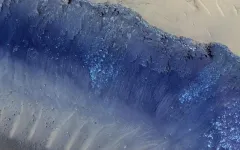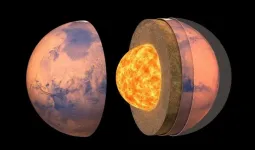(Press-News.org) UNIVERSITY PARK, Pa. -- Infection with dengue virus makes mosquitoes more sensitive to warmer temperatures, according to new research led by Penn State researchers. The team also found that infection with the bacterium Wolbachia, which has recently been used to control viral infections in mosquitoes, also increases the thermal sensitivity of the insects. The findings suggest that global warming could limit the spread of dengue fever but could also limit the effectiveness of Wolbachia as a biological control agent.
"Dengue fever, a potentially lethal disease for which no treatment exists, is caused by a virus, spread by the bite of the mosquito Aedes aegypti. This mosquito is also responsible for transmitting a number of disease-causing viruses, including Zika, chikungunya and yellow fever," said Elizabeth McGraw, professor and head of the Department of Biology, Penn State. "Aided by increasing urbanization and climate change, this mosquito's range is expected to overlap with 50% of the world's population by 2050, dramatically increasing the number of people who could potentially be exposed to these viruses."
In recent years, research groups around the world have attempted to control these viruses by infecting Ae. aegypti with the bacterium Wolbachia pipientis and then releasing the mosquitoes into the environment, McGraw explained.
"Wolbachia have been shown to prevent viruses, including dengue, from replicating inside mosquitoes," she said. "Importantly, Wolbachia are passed down to the mosquitoes' offspring, making them a self-propagating and lower-maintenance approach to disease control in the field."
McGraw noted that both dengue virus and Wolbachia infect a variety of tissues throughout a mosquito's body, and although they are not toxic, they do evoke an immune stress response.
"Since mosquitoes that are infected with dengue virus and/or Wolbachia are already suffering a stress response, we thought that they would be less well equipped to deal with an additional stressor, such as heat," she said.
To investigate the effects of heat on dengue and Wolbachia-infected mosquitoes, the team placed infected mosquitoes in sealed vials and then submerged the vials into a water bath heated to 42°C -- a realistic temperature extreme that a mosquito might encounter in the wild. The researchers then measured how long it took for the mosquitoes to become immobilized and compared the time to uninfected control mosquitoes. Their findings appear today (July 22) in the journal PLOS Neglected Tropical Diseases.
"After a lot of trial and error, we were successfully able to adapt a heat-based physiological assay commonly used in Drosophila [a model fruit fly species] to our mosquito species to examine the impact of both dengue virus and Wolbachia infections on thermal sensitivity," said Fhallon Ware-Gilmore, graduate student in the Department of Entomology and Center for infectious Disease Dynamics at Penn State who led the project.
The team found that mosquitoes infected with dengue virus showed greater sensitivity to heat; they became immobilized almost three times faster than uninfected mosquitoes when placed in the hot water bath. Similarly, mosquitoes infected with Wolbachia became immobilized four times faster than uninfected mosquitoes.
Interestingly, Ware-Gilmore said, the two agents -- dengue virus and Wolbachia bacteria -- did not have an additive effect on mosquito thermal tolerance.
"You might expect that mosquitoes infected with both dengue virus and Wolbachia might become immobilized even faster than mosquitoes infected with only one or the other microbe, but we did not find an additive effect," she said. "We are, however, the first to show that viral infection can affect mosquito thermal tolerance, specifically by reducing mosquito survival during exposure to high heat. And, while there are some known interactions between heat and Wolbachia, particularly in immature stages, this is also the first study to show that adult infected-mosquitoes have reduced survival during heat stress."
Ware-Gilmore noted that future climate models point to increasing frequencies of extreme temperature events, making short exposures to high temperatures a threat to the survival of dengue and Wolbachia infected mosquitoes.
"At lower temperatures, we know that dengue virus may fail to replicate fast enough to make it through the mosquito body and be transmitted, thereby reducing transmission risk," she said. "At higher temperatures, while the virus may replicate faster, our work suggests that a corresponding reduction in mosquito thermal tolerance may act as a counterforce on mosquito survival that could help to reduce transmission and potentially human disease incidence in hotter, more climate-variable regions. Similarly, our work suggests that Wolbachia may fail to work as a biocontrol agent in hotter regions given its effect on mosquito survival."
INFORMATION:
Other Penn State authors on the paper include Heverton Dutra, postdoctoral scholar in entomology; Matthew Jones, research assistant, Huck Institutes of the Life Sciences; and Katriona Shea, professor of biology and Alumni Professor in the Biological Sciences. Also on the paper are Carla Sgrò, professor of biological sciences, and Matthew Hall, senior lecturer in biological sciences, Monash University; Zhiyong Xi, professor of microbiology and molecular genetics, Michigan State University; and Matthew Thomas, director and professor, York Environmental Sustainability Institute, University of York.
The International Networks of Excellence and Penn State supported this research.
NOTICE: This summary has been updated to correct misspellings of the last names of both Perspective authors. The Perspective authors are Sanne Cottaar and Paula Koelemeijer. We apologize for our error.
The first direct seismic observations from NASA's InSight lander, presented in three studies in this issue, provide clues to the composition of Mars. Researchers across these studies report preliminary findings from the Insight mission and begin to map - for the first time - the interior of a planet apart from Earth. "These three studies provide important constraints on the present-day structure of Mars and are also key for improving our understanding of how the planet formed billions of years ago and ...
In the suburbs of Sydney, Australia, sulphur-crested cockatoos routinely loot lidded household waste bins to scavenge for food. In a new study, researchers document the emergence and geographic spread of innovative bin-opening behaviors in urban parrot populations, revealing the presence of a complex social learning culture in these birds. What's more, this behavior appears to have emerged as a direct response to land-use change and urbanization, demonstrating how animal cultures could allow for local adaptation of urban animal populations in the Anthropocene. In animals, ecological novelty, including novelties unique ...
Of the nearly 100 SARS-CoV-2 vaccines currently undergoing clinical trials, only seven are delivered intranasally - despite this vaccine type's long success in providing protection from influenza. In a Perspective, Frances Lund and Troy Randall argue that intranasal vaccines could be beneficial in the continued fight against COVID-19, especially considering respiratory viruses like SARS-CoV-2 predominantly enter the nasal passage first. Currently authorized COVID-19 vaccines are delivered via intramuscular injection, where they elicit systemic immune responses and central immune memory. While several ...
Like dreaming of walking through a world they've not yet experienced, the retinas of neonatal mice practice for what mature eyes must later process by generating spontaneous patterns of activity that mimic the perception of directional movement through space, according to a new study. Essential functions in the mammalian visual system, including the ability to locate objects and detect motion, are present even at the first onset of vision. Optic flow, the perceived relative motion of objects and surfaces that seemingly stream by a field of vision during movement, is one of these functions. However, how the visual system organizes its functional characteristics before visual sensory experience is even possible remains unclear. ...
Based on the analysis of marsquakes recorded by NASA's InSight mission, the structure of Mars's crust has now been determined in absolute numbers for the first time. Beneath the InSight landing site, the crust is either approximately 20 or 39 kilometres thick. That is the result of an international research team led by geophysicist Dr Brigitte Knapmeyer-Endrun at the University of Cologne's Institute of Geology and Mineralogy and Dr Mark Panning at Jet Propulsion Laboratory, California Institute of Technology (Caltech). InSight stands for 'Interior Exploration using Seismic Investigations, Geodesy and Heat Transport'. NASA's lander, which ...
New European Union regulations on batteries could offer a huge boost to the global decarbonisation mission - but only if it leverages its political and economic weight to ensure a fairer global marketplace.
According to a team of scientists and researchers writing in Science, the new regulations, due to come into force from January 2022, have the potential to unify policy on approaches such as recycling, use of recycled raw materials, and creating a circular economy.
Contributing to the study were experts at Newcastle University, the University of Birmingham, Circular Energy Storage Research and Consulting, ...
As a newborn mammal opens its eyes for the first time, it can already make visual sense of the world around it. But how does this happen before they have experienced sight?
A new Yale study suggests that, in a sense, mammals dream about the world they are about to experience before they are even born.
Writing in the July 23 issue of Science, a team led by Michael Crair, the William Ziegler III Professor of Neuroscience and professor of ophthalmology and visual science, describes waves of activity that emanate from the neonatal retina in mice before their eyes ever open.
This activity disappears soon after birth and is replaced by a more mature network of neural transmissions ...
Using information obtained from around a dozen earthquakes detected on Mars by the Very Broad Band SEIS seismometer, developed in France, the international team of NASA's InSight mission has unveiled the internal structure of Mars. The three papers published on July 23, 2021 in the journal Science, involving numerous co-authors from French institutions and laboratories, including the CNRS, the Institut de Physique du Globe de Paris, and Université de Paris, and supported in particular by the French space agency CNES and the French National Research Agency ANR, provide, for the first time, an estimate of the size of the planet's core, the thickness of its crust and the structure of its mantle, based on the analysis of seismic waves reflected ...
For much of human history, animals and plants were perceived to follow a different set of rules than the rest of the universe. In the 18th and 19th centuries, this culminated in a belief that living organisms were infused by a non-physical energy or "life force" that allowed them to perform remarkable transformations that couldn't be explained by conventional chemistry or physics alone.
Scientists now understand that these transformations are powered by enzymes - protein molecules comprised of chains of amino acids that act to speed up, or catalyze, ...
The rapid spread of the Alpha variant of COVID-19 resulted from biological changes in the virus and was enhanced by large numbers of infected people 'exporting' the variant to multiple parts of the UK, in what the researchers call a 'super-seeding' event.
Results of the largest phylogeographic analysis ever conducted, published today in the journal Science, maps the spread of the variant (also known as lineage B.1.1.7) from its origins in Kent and Greater London in November 2020 to all but five counties in Wales, Scotland, Northern Ireland and England by 19 January.
Dr ...



